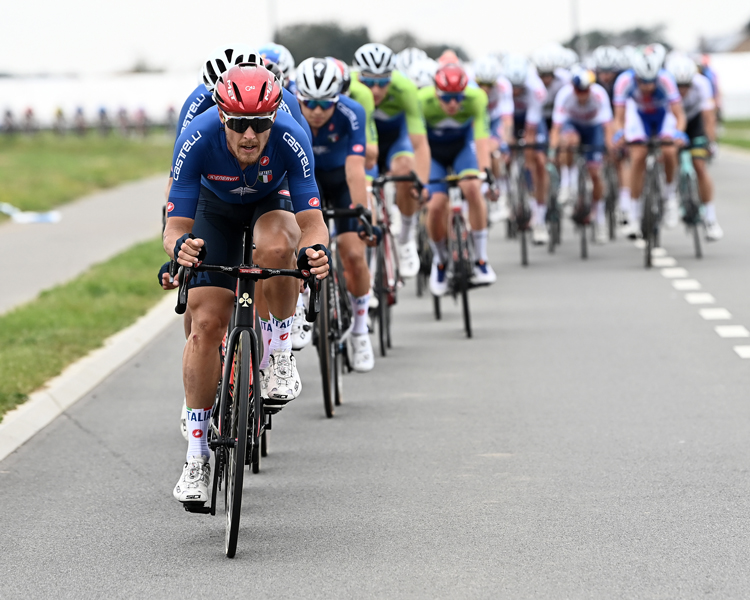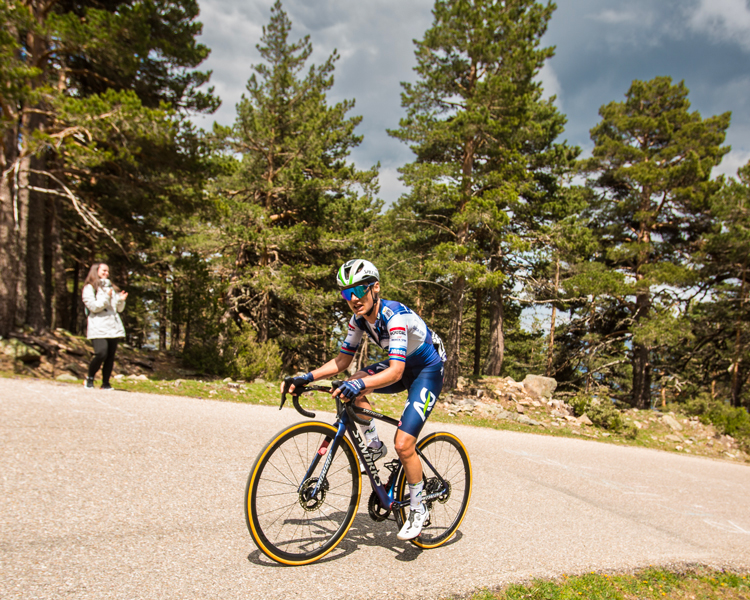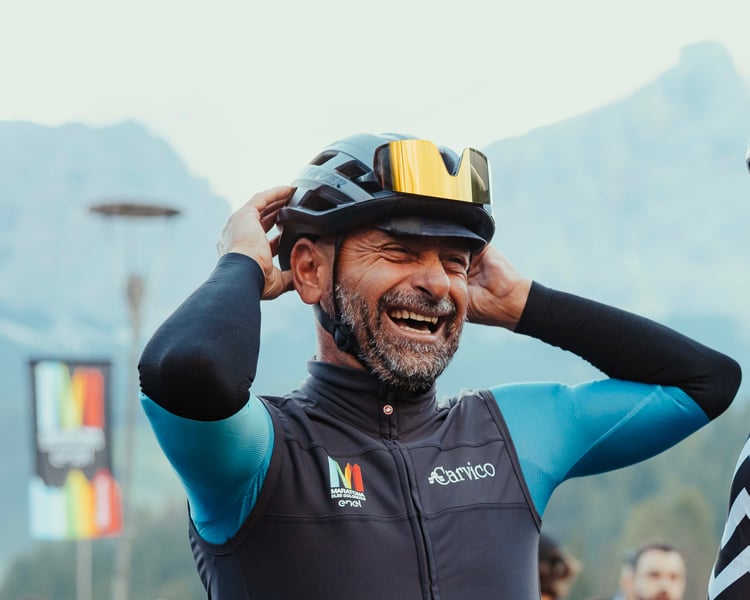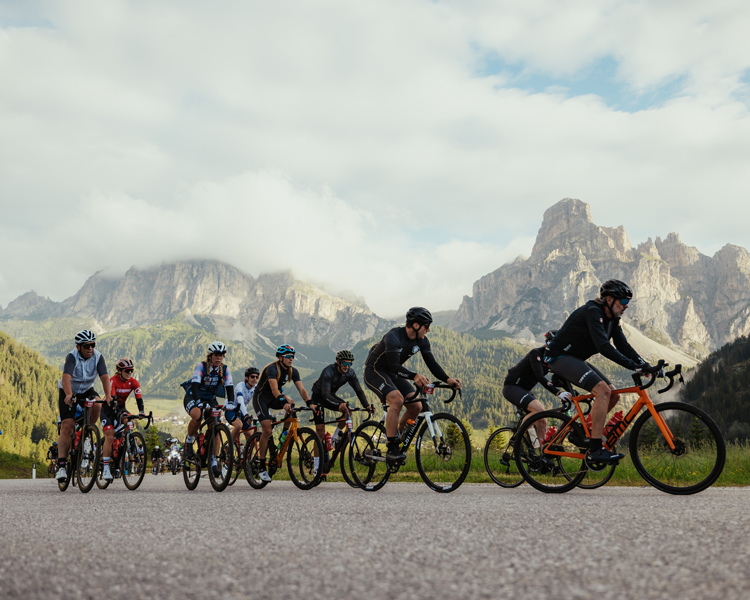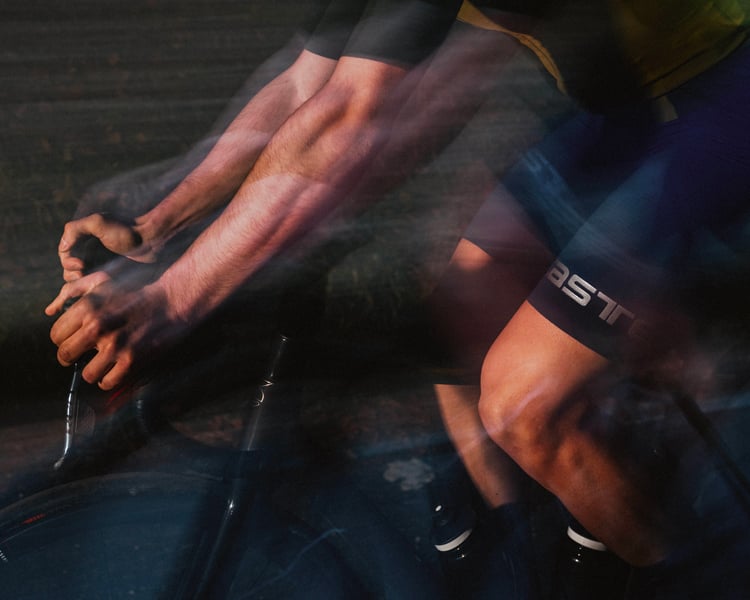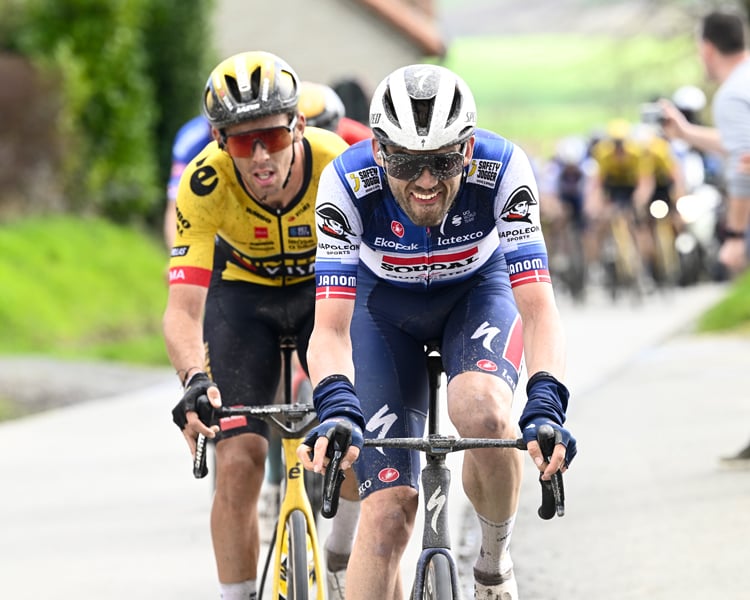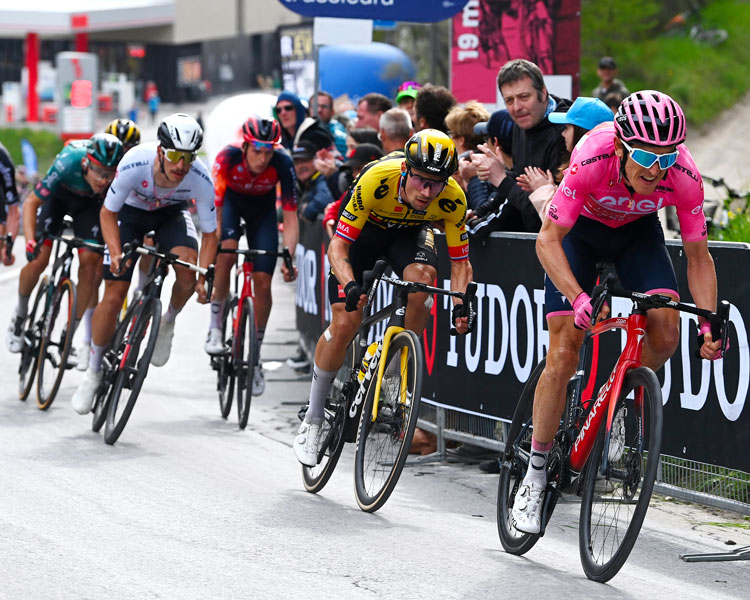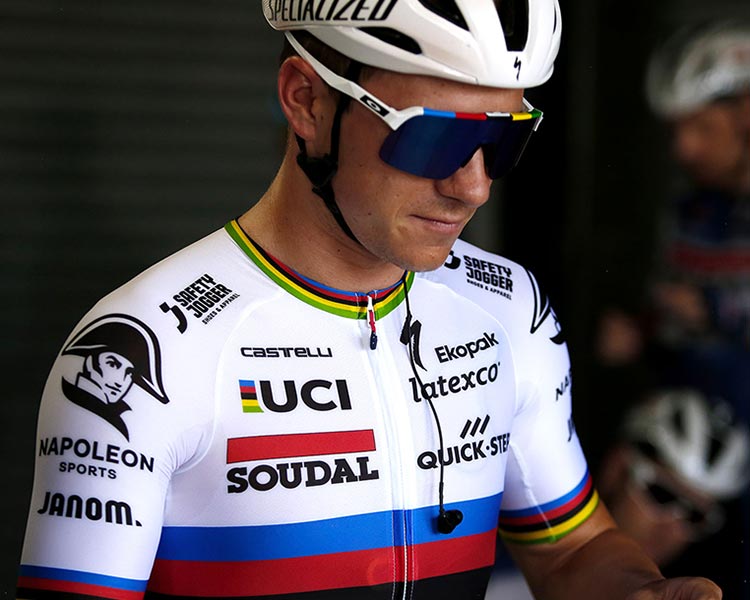
During this episode of the Castelli Podcast, the Olympic Madison gold champion opens up about lead-out strategies, how he became the ultimate lead-out man, his most cherished victories, his favorite Castelli gear, and more.
TOPICS COVERED & TRANSCRIPT
(00:00) Welcome
(02:49) The lead-out rider’s role
(06:06) Madison vs. mass road sprints
(09:40) Lead-out train, best practice
(10:50) Trust between the sprinter
(11:52) Conducting sprint finish research
(12:50) Acting on instinct
(13:44) Power numbers
(14:51) Joining Quick-Step in 2018
(16:07) Advice to upcoming young cyclists
(17:17) Winter training in Denmark
(19:20) Favorite Castelli winter jacket (Alpha RoS 2)
(20:45) Go-To Road Speed Suit (BTW)
(22:30) Dreamer or Realist
(23:24) Time to hang-up your bike?
(24:20) Favorite moment
(25:46) Optimizing bike performance
(27:21) Slowing down the mind
(29:00) Finish
SOREN JENSEN
If you ever watched a pro rider pop out of the bunch with just a few hundred meters to go in an almost 200km race and win, you probably wondered how they do it and where on earth. Hello everyone and welcome to today's episode of the Castelli Podcast. Today we have a very special guest with us, a person who is considered the best lead-out rider in the pro peloton. He has fulfilled this job for the likes of Mark Cavendish, Peter Sagan, Elia Viviani, Alexander Kristoff, Sam Bennett and Fabio Jakobsen. Please welcome Michael Mørkøv of Soudal Quick-Step.
MICHAEL MØRKØV
It was a very hectic final today. It was very hard to stay organized like we wanted. With a boulevard sprint like this, it's extremely difficult, but we kept our head cold and stayed calm and came to the front at the right moment.
SOREN JENSEN
We'll learn more about the influences that inspired him to take up cycling and set him on this remarkable path. Michael says that becoming a lead out specialist was not initially a smooth ride. He describes his early bunch sprint attempts as a big mess, struggling to find his way in the fast pace sprinting chaos. However, over the years something shifted and he evolved into the masterful lead-out specialist we know today. He even admits that while he finds it easy now, he still can't fully explain the gift that enables him to excel in this role. With a wealth of experience and confidence, Michael seamlessly maneuvers through the peloton, ensuring his sprinters in the best possible position before launching him into the crucial final meters going for the victory. We'll also get insights into Michael's favorite aero race suit and winter gear that will keep him warm and dry riding through the harsh and challenging Danish winter month along with other topics. So sit back, relax and kick your feet up as we embark on a thrilling and insightful conversation with the incredible Michael Mørkøv. But before delving into the interview, let me provide you with a quick rundown of what a lead-out man's role is, especially if you're new to cycling or haven't encountered the term before. And if you already know what a lead-out man is, you can use the chapter links in the show notes or just fast forward to around 5 minutes to embark on the interview with Michael. A lead-out is the process in which a team sprinter is strategically delivered to the final of a race by his teammates in optimum condition to be able to execute his speciality and explosive sprint for the victory. It happens in certain stages of Grand Tours and shorter stage races, but also in one-day races where the parkour favors a sprinter and is an extremely technical piece of tactical maneuvering. A lead-out train will ride in formation, with the riders involved taking turns to lead and each having a specific role. The unit protects and shields its sprinter until the moment is right for the sprinter to jump and unleash the sprint. Shading the sprinter from the wind and letting them draft for as long as possible, the leadout can achieve one of its two main goals, which is allowing the sprinter to save up to 30% of energy even in the most demanding and brutal of finishes. The second primary goal of a lead out is to position the sprinter perfectly. Lead out riders exert extraordinary physical efforts and combined with their ability to identify the right gaps and positions allowing them to swiftly anticipate the unfolding moves. This process makes the lead out a unique and complex endeavor. Now you might be wondering how the lead out train unfolds? Well, as the finish approaches in a pro race, the pace rises dramatically, often reaching up to 60 or 70 km inside the final kilometers as the tension rises and the various lead outs from different teams compete for position. Once inside those 500 meters, the final lead out rider, in this case Michael Mørkøv, then takes over and will be doing one of two things either cracking up the pace until a full-on sprint unleashes and he or she drops off or to get their sprinter into the perfect position in a now crowded bunch which is moving fast and furiously. Finally the last move is down to the sprinter. They have to decide when to open their effort and kick for the sprint. Usually this happens with just 150 and 200 meters to go when the sprinter will jump off their last lead out rider's wheel and straight onto the wind or will jump onto the wheel of a competitor to get one last slingshot into the crucial final meters. If you're curious to see how all of this is unfolding I'll drop a link in the podcast notes to a Villain video taking you through the last 300 meters of the 2019 Ride London race where Michael meets his former teammate Ilija Viviani to victory, dropping him off at around the 150 meter mark.
SOREN JENSEN
Hi, Mikael, Thank you for joining us today on the Castelli Show. How are you doing? Hello, thank you very much.
MICHAEL MØRKØV
I'm all fine.
SOREN JENSEN
Your accomplishments in the world of cycling are truly inspiring. Three time Danish road race champion, state's winner at the La Vuelta, and widely considered the best lead out man in the business. But you're also a rock star on the track with Olympic Madison gold in Tokyo, four World Championship gold medals and one at the European Championship. With your remarkable journey in the Madison discipline, which is known for being one of the most dramatic and hectic track events, the same chaos and intensity of a mass road sprint can be quite similar.
MICHAEL MØRKØV
Absolutely, over the years I really start to compare a Madison with a bunch sprint as well, because it's both a discipline in cycling where it demands a lot of the riders in terms of having an overview of what is happening, not only with yourself, but also with all the guys you're racing against, but also you need to be really skilled to find a way and just to be able to navigate in a chaos that's the same for Madison and for bunch sprints.
SOREN JENSEN
As a lead-out man, your ability to bring your sprinter to the finish line with such ease is often praised by your former and current teammates and sport directors. Can you share some insights into the mental and tactical aspect of your role during those critical moments in a race?
MICHAEL MØRKØV
Well, I think that maybe I have it as a human gift, maybe, because I also feel I'm like that in private life. The more difficult my situation is, the more calm I will actually be. So for example at home, when we have three kids and or we are running late or whatever. That's where I'm actually most calm and maybe just focused on the target. I think the main thing is to always have the eyes on the target and not on everything
SOREN JENSEN
around you. So what if plan A isn't working out or you're short on lead out men in the lineup coming into the last one or two kilometers. How do you improvise? Do you try to use the advantage of jumping onto other lead out trains?
MICHAEL MØRKØV
Well, coming into a bunch sprint, I kind of know who are we sprinting against, which teammates do they have, how strong of a lineup do the other team have. So I kind of have an idea of how to navigate. And then when we are there in the situation, and let's say that I lose one or two teammates too early, too early and unexpected, then I need to have a plan B. And it's not that I have a written down plan B, but it's more like my instincts tell me that, okay, I see this team over there, this is a strong team and they are good organized. So that's the team who's going to bring us further. It's more about having analyzed the race before and being able to use that information in the heat of the moment.
SOREN JENSEN
What about other teams? Do they try to block you out knowing that you can be a significant threat?
MICHAEL MØRKØV
I don't feel that somebody is blocking me out. Maybe I feel sometimes that actually they give me a bit of a space because they usually know if they find the quick-step train, they have a good chance to sprint for the win, victory in the race. So many times we are marked and I also happened a few times in the sprint that 500 meters to go everybody was looking at me or at us waiting what are we going to do and yeah it's quite rare in a bunch sprint because normally it's just all to the finish line but I had a few times that I had the feeling that everybody was waiting for us and we could actually give us time to get organized.
SOREN JENSEN
Well, Michael, it's fascinating to see how your decision-making process unfolds during the last few kilometers of the race. How frequently does your team, Soudal Quick-Step, train the lead-out, train doing practice to
MICHAEL MØRKØV
fine-tune the coordination and almost synchronization in the last few kilometers of the race. We don't train much. Normally in December training camp and January training camp we have a chance to work on the lineup and feel the speed of each other. But I really believe that the only way that you can train a lead out is in a race. And that's why I'm strongly believing that if you have a top sprinter that you're riding for, it's very important that that sprinter have his riders with him in many races so that you not just meet for let's say the Tour de France which is the most important in a year but you do many races before as a practice to to
SOREN JENSEN
hit the big target. You're definitely one of the best artists when it comes to being the best lead out person. When you provide a secure and smooth ride for your sprinter, sitting on your wheel, they can trust you to guide them through the gaps and deliver them safely to the last 150 meter mark before they will jump off your wheel and straight into the wind and hopefully achieve their victory. This trust is a crucial element of your success. Can you tell us more about the importance of trust and how it affects your performance as a lead-out man?
MICHAEL MØRKØV
But I think that's also one of my main focuses, is to gain the confidence from the sprinter that I'm working with. So I'm putting a lot of effort into knowing the sprinter and getting a personal relationship with him, so that I know that he, or he knows he can trust me in the very difficult situations where it's all about his palmaris and his career. He needs to trust me and not go his own way. So I truly believe that many of the success I had with the many sprinters is because I got that trust from
SOREN JENSEN
the sprinter. The level of trust you inspire among your teammates is remarkable. Another key aspect of your role is the extensive research you undertake before races studying the road book, billiard viewer or Google Street View. Do you conduct this research individually or is it a collaborative effort with your fellow teammates? And how does this preparation influence your performance on the road later?
MICHAEL MØRKØV
That really depends a lot on my teammates. Some teammates just show up and they do whatever they are told. But of course I have teammates who are also very interested in the details and how we can do the best possible lead out. Also our sport directors do a big job and I like to do it as well because then when we meet and we talk about the final, maybe my sport directors see it in one way and I see it in a different way and then we can talk about what's actually going to happen. For me to gather as much information as before just makes increasing the chances of hitting it right.
SOREN JENSEN
Given the ever-changing conditions on the road, decisions often need to be made on the fly. How much freedom do you and your fellow teammates have to make these decisions during a race, especially when weather conditions and wind directions may differ from the initial race plan provided by the sports directors?
MICHAEL MØRKØV
They also really respect that we as a rider, we are the only ones who can feel what is necessary. When do we need to increase the speed? When do we maybe need to hold off a bit? When can we wait because the wind is strong from the face? What I really believe that works for me is trusting my instinct when I'm there on the last case. So normally I tell my teammates when we're coming into the sprint roughly what I think we should do when we know how the finish is and how the competitors are. But I really try to have such an open plan that I can follow my instinct also in the moment.
SOREN JENSEN
We all know that the power and speed generated during those bunch sprints are super high like 1500-1600 watts and 65-70 kilometers an hour. How many watts are you typically generating during a sprint?
MICHAEL MØRKØV
Oh, well, those numbers vary quite a lot. Myself, I won a stage in the world years ago on 1150 watts. And so when I tell that to guys, they're thinking that I was not even sprinting because it's not so much compared to what the big guys can push. But I know it's not all about the peak power. Also for me, the quality that I have as a leadout man is that I can produce a good part above 1,000 watts for more than 20 seconds if it's necessary. A sprinter, some they push 1,800 watts, some can win sprints on 1,300. Those numbers are not so important to me. The most important is which speeds you can reach.
SOREN JENSEN
Correct. Maintaining a high and consistent speed is crucial as the sprinters patiently wait, sheltering from the wind to save energy and watching everyone for the first sign of their rivals launching. What motivated you to join Quick-Step back in 2018 and what has your experience been like with the
MICHAEL MØRKØV
team so far? Well, first of all I felt extremely lucky and proud that I got the chance to join the team in 2018 after two years with Alexander Kristoff at Katusha, where I kind of started as a lead-out man. Then I got in here and I was really back in the queue. I had to work my way up, but I was very lucky I joined the team at the same time as Ilya and we got a very good relationship up going from the first race of the year and first race, first year I won with him 10 races so I really I proved my point as a lead out man for him and I also got I developed as a rider to get into this team who had all this knowledge about bunch sprints so I think that was just the the perfect step for me in my career to join this team and I think from 18 we really developed together and still keep on this momentum as a sprint team.
SOREN JENSEN
Your remarkable career has inspired many and young cyclists aspire to follow in your footsteps. What advice would you give to upcoming cyclists who wish to excel in the art of lead out and become successful like you.
MICHAEL MØRKØV
I think the best advice I can give is just keep focusing on yourself and keep working on whatever you do. That's pretty much what I did because I was never that bright talent who was supposed to be a professional bike rider even. But I just with the tip of my nails got a contract in 2009 with Bjarne Riis in Saxo Bank and and then I proved my point and I got extended my contract and I kind of happened to grow every year like that and I've been everywhere I've been a part of a classic team I've been a part of a domestic team around Alberto Contador as a semi climber I had the Polka Dodgers in the Tour de France myself. And the last couple of years, I'm more of a sprinter, a lead out, and as well I'm competitive on the track. So I've been pretty much around, I would say.
SOREN JENSEN
Michael, let's get off the pro cycling chat for a bit. After a few years living in Tuscany, you and the family decided to move back to Denmark, where the cold and wet winter months can be harsh to get through, but also harden you as a cyclist.
MICHAEL MØRKØV
Yeah, I used to live in Italy and that was like a paradise as a pro bike rider. I had nice weather almost every day the year round. But I moved in 2015 back to Denmark and there I really knew that I had to find different ways to challenge myself because the weather in the winter can be really rough in Denmark, a lot of wet conditions, cold conditions.
SOREN JENSEN
Escaping the wind chill and the wet roads in winter time, I would usually grab my mountain bike and go into the woods and do most of my training there.
MICHAEL MØRKØV
Indeed, I started on a cross bike to do gravel, which is a new thing today, but I did it for many years. I find all the big gravel parts around Copenhagen and I actually managed to do quite long rides without stopping for red light which is already a quite of
SOREN JENSEN
achievement when you live in Copenhagen. Do you cross train in any other sports activities during winter such as mountain biking, running, swimming to
MICHAEL MØRKØV
diversify your training routine? Well I actually really like to do different kind of training because an average week of training as a pro rider is between 20 and 25 hours so if you have to do all of these hours on a bike in one degree and rain it's a very long winter but I challenge it with doing quite some running, I do gym, I go in the forest on my gravel bike even sometimes on mountain bike and then the hours on the road bikes will be less because I do so many other things. So I really enjoy the winters to have that variation in my training.
SOREN JENSEN
That's good, too. It's good to detach yourself a little bit from wintertime, from cycling. Michael, you have full access to Castelli's Rosso Corsa line of products, innovated to perform at high speeds and protect cyclists from the elements during wet and cold training rides. What's your go-to Castelli winter kit for staying warm and comfortable during training in the Danish climate?
MICHAEL MØRKØV
Well, I would actually say the Alpha jacket. I say it to everybody who wants to listen actually because it's such a heavy jacket that you can have on even in the coldest condition. When you live in Denmark and winter can be rough, four hours in rain and one degree, it's not waterproof but also the water is not coming through. It's not like a rain jacket but it still keeps me dry and warm. So for me the Alpha jacket is the best cycling product I ever had. It always helped me and especially living in Denmark. But you can also have it on in a warmer condition. So actually when you have such an Alpha jacket you are covered in any aspect and different to all the other winter jackets I had in the past. Like, let's say it's 5 or 10 degrees and you have it on, I will not get sweaty and wet inside because it's such a good material who can also breathe. So, I mean, when I moved back in 2015, the first thing I did was order a big package of Castelli, they helped me through many cold winters in Denmark.
SOREN JENSEN
That's good to hear. Having access to all Castelli's aero road suits, which suit is your go-to speed suit for racing depending on the race course and conditions?
MICHAEL MØRKØV
Well for me the most important is obviously the sprint stages. Could also be with some hills, but anyway it's decided at the end where you want to be as fast as possible and break the wind as good as possible. So, for sure the fastest suit we have is the BTW and I really enjoy putting that on. It's really tight and when I put it on I feel really aero, so when I put the BTW suit on I also feel like really racing and looking forward to getting into a bunch sprint.
SOREN JENSEN
I completely agree with you also because with the BTW there are huge error gains and watch savings when the race speed is high and especially doing those chaotic fast sprints when you guys are going 70 kilometers an hour. And a quick note for our listeners who cares about marginal gains and error performance what's particularly exciting about the BTW speed suit and all the other performance enhancing products that Castelli supplies to Soudal Quick-Step is that even amateur cyclists can enjoy the exact same air advantages that we provide to our professional cyclists through the Castelli Cerviccio Corsa Custom Team Program and inline collection. So head over to our website for more information. What does streaming mean to you as a professional cyclist, but even just as a cyclist also when you were an amateur?
MICHAEL MØRKØV
I don't think I was much of a dreamer myself so I cannot paint that that pink picture, but I always had quite high ambitions, but also very realistic ambitions and that's it can actually sound quite boring, but I think that's what brought me far because I was never dreaming about being world champion or Olympic champion and winning the Tour de France, but in the end it actually happened for me on the track. I have also now been a part of many stage wins in the Tour de France, which was also kind of a dream or a realistic dream for me. I always had realistic goals and dreams with me.
SOREN JENSEN
You're 38 years of age. Your longevity in the sport is truly impressive. Looking ahead, how much longer do you see yourself continuing as a professional cyclist? And what aspects of being a pro cyclist bring you the most pleasure and excitement, keeping the passion alive in your career?
MICHAEL MØRKØV
Well, already a few years back, I thought now I'm going to take it year by year. I feel I achieved a lot. I've been everywhere, I've tried all the races I want to try. But I still really enjoy being a bike rider. I enjoy the daily training, I enjoy being in shape. And most of all I really enjoy competing. So one of the best signs I know is when I go to the track in Copenhagen for a night of racing and before going there I can still feel that I'm nervous and I'm preparing my bike. When I feel that density inside I know that I'm still doing the right thing and also I'm forever excited about the bunch sprints because none of the bunch sprints is the same so every single bunch sprint is different, it's different riders we're riding against, a different parkour, it's different teammates you have. Everything is always different, so I'm constantly inspired by the next bunch sprint.
SOREN JENSEN
If you had to pick one special moment in your career, what would that be?
MICHAEL MØRKØV
That would be when I raised my arms in Tokyo winning the Olympic gold medal.
SOREN JENSEN
Why?
MICHAEL MØRKØV
Because I achieved many things that I'm very proud of. I didn't win as many races as Cavendish or many other colleagues I had, but I want to say that all that I won, I'm extremely proud of. So that's from the stage I had in the world cup, from the Copenhagen six days, world championships titles, Danish championships titles, but I'm really proud of it all. But of course the outstanding one
SOREN JENSEN
is the Olympic gold medal. Yeah, that was a beautiful moment. Yeah, and I agree Personally, I have a lot of favorite Michael Merkur moments in my book But one that really stands out is the one that you also mentioned earlier During the Tour de France where you wrote in the breakaway in the polka dot jersey I still remember that photo with you in the solo breakaway cutting through those sunflower fields. Michael, it's evident that you are a master when it comes to optimizing your bike performance. You take great care in fine-tuning every aspect, including your clothing and equipment, to gain any advantage you can. I'm curious, do you often find yourself readjusting your bike even after the mechanics have set it up, or do they generally fine-tune everything to ensure it's spot-on and precisely tailored to your preferences, including your spare bikes?
MICHAEL MØRKØV
Well, actually, I always spend a lot of time to know my mechanics and to know how they work and how they work on the bikes. And I try not to adjust myself because in the end it's their bikes. But I always check my bike really well before riding on it. And if I have any remarks, I will always ask to get it adjusted. Sometimes I'm afraid to be one of the riders who is a bit of a pain in the ass. But on the other hand, it's also a matter of safety. That you know that whatever you're riding on is tight and well, and the gear is adjusted in the right way. And it's also a performance aspect. So I think all mechanics I met in Macquarie, they always respected that I'm very detailed about my equipment and they're always happy to help me.
SOREN JENSEN
Your product feedback is invaluable for us. Your specific and clear vision about what you want and how we can improve the Castelli products is a key to the success of the perfect partnership of a performance enhancing clothing brand as Castelli. It's making it an absolute pleasure to work with you. You're always available and want to help fine-tune everything. Not only Castelli but also the other partners of the team and cycling brands make better products. When you are at a stage race or a grand tour or just a training camp, what do you usually do in the evening after dinner? Do you read books, watch Netflix or what do you usually do to slow down the mind?
MICHAEL MØRKØV
I'm actually most on my social media and actually I kind of hate social media when I'm at home because I really want to be a dad and a husband with my family so there I always try to put it away. But I actually found that social media is a very good thing when I'm traveling and when I'm away, because it's something that you can look at for five minutes or for one hour and you have to kill time. Sometimes you can be a bit stressed if you want to see a movie and the movie is longer than the time slot that you have. So actually social media is an easy way just to scroll down through whatever's coming up. And I also feel that that's also a way to get news. So it's a bit the same as reading whatever newspaper. So also you get a bit informed of what's going around other places than in the cycling world.
SOREN JENSEN
Finally, let's conclude this episode with some quick fire rounds of questions. Do you prefer cobbles or gravel roads?
MICHAEL MØRKØV
I like both. I like cobblestones in a race, but I also enjoy the gravel. Okay, I have to say cobblestones if we talk about a race. Okay, crosswinds or mountains? Crosswinds. Training or racing? Racing.
SOREN JENSEN
Of course, that's precisely why you are considered the best lead out man in the business and being a professional cyclist. It was great having you on the pod and catch up with you in person again. Thank you for your time and I look forward to seeing you again sometime soon.
MICHAEL MØRKØV
Yeah, thank you. You too.
SOREN JENSEN
And thanks for having me. Thanks to Michael Mørkøv for joining us on the Castelli Show and telling us about his long cycling career and how he turned himself into the best lead out man of the sport. His favorite Castelli products for riding through the harsh winter in Denmark and his favorite race suits. If you enjoyed this episode, please make sure to subscribe, give us a 5 star rating to help us be seen by other cyclists in the algorithms. And if you have a Castelli product related question or topic you would like us to take up on a future episode, email us through the contact form on the Castelli website. And I'll also drop the email address in the podcast notes together with the other important links from this interview with Michael Mørkøv. Thanks again everyone and see you soon.
